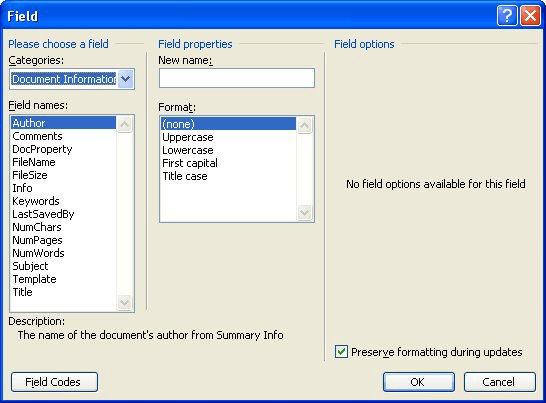Please Note: This article is written for users of the following Microsoft Word versions: 97, 2000, 2002, and 2003. If you are using a later version (Word 2007 or later), this tip may not work for you. For a version of this tip written specifically for later versions of Word, click here: Inserting Summary Information.
Written by Allen Wyatt (last updated March 26, 2022)
This tip applies to Word 97, 2000, 2002, and 2003
Word keeps track of summary information for a document. You can either use this summary information, or you can ignore it. Some of the summary information is automatically created for you while other parts need to be entered manually. One of the pieces of information maintained is the author of a document. This is originally set to be the Word user name, but you can change the author name at any time. Word allows you to insert summary information such as the author's name directly in your document, and have it updated automatically if you should ever change the information. This is done by following these steps:

Figure 1. The Field dialog box.
There are many different bits of summary information you may want to include in your document. Here are a few:
| Field Name | Description | |
|---|---|---|
| Author | Name of the document's author | |
| CreateDate | Date the document was created | |
| FileName | Document's name and location on disk | |
| FileSize | Size of the document's disk file | |
| LastSavedBy | Word user name of the last person to save the file | |
| NumChars | Total number of characters in the document | |
| NumPages | Total number of pages in the document | |
| SaveDate | Date the document was last saved | |
| Subject | Subject of the document | |
| Template | Name of the document's template | |
| Title | Document's title |
You should note that not all of these fields can be inserted by selecting the Document Information category (step 3). For instance, CreateDate and SaveDate are inserted, instead, by first selecting the Date and Time category.
WordTips is your source for cost-effective Microsoft Word training. (Microsoft Word is the most popular word processing software in the world.) This tip (386) applies to Microsoft Word 97, 2000, 2002, and 2003. You can find a version of this tip for the ribbon interface of Word (Word 2007 and later) here: Inserting Summary Information.

The First and Last Word on Word! Bestselling For Dummies author Dan Gookin puts his usual fun and friendly candor back to work to show you how to navigate Word 2019. Spend more time working and less time trying to figure it all out! Check out Word 2019 For Dummies today!
Updating form fields in Word can be confusing, especially when the fields are locked in a form. This tips explains why ...
Discover MoreWord allows you to place all sorts of fields in your documents. If you want to search for only specific types of fields, ...
Discover MoreTired of messing with inserting the date and then changing it to a format that is more to your liking? There's a quick ...
Discover MoreFREE SERVICE: Get tips like this every week in WordTips, a free productivity newsletter. Enter your address and click "Subscribe."
There are currently no comments for this tip. (Be the first to leave your comment—just use the simple form above!)
Got a version of Word that uses the menu interface (Word 97, Word 2000, Word 2002, or Word 2003)? This site is for you! If you use a later version of Word, visit our WordTips site focusing on the ribbon interface.
Visit the WordTips channel on YouTube
FREE SERVICE: Get tips like this every week in WordTips, a free productivity newsletter. Enter your address and click "Subscribe."
Copyright © 2025 Sharon Parq Associates, Inc.
Comments